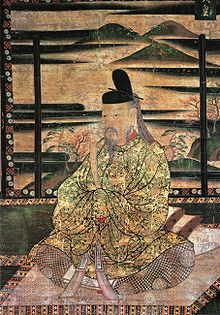Emperor Saga
| Emperor Saga 嵯峨天皇 |
|||||
|---|---|---|---|---|---|
 |
|||||
| 52nd Emperor of Japan | |||||
| Reign | 18 May 809 – 23 May 823 | ||||
| Predecessor | Emperor Heizei | ||||
| Successor | Emperor Junna | ||||
| Born | 10 October 786 | ||||
| Died | 24 August 840 (aged 57) | ||||
| Burial | February 24, 1989 Saga no yamanoe no misasagi |
||||
| Spouse | Empress Danrin | ||||
|
|||||
| Father | Emperor Kanmu | ||||
| Mother | Fujiwara no Otomuro | ||||
| Full name | |
|---|---|
| Kamino (神野?) |
Emperor Saga (嵯峨天皇 Saga-tennō?, (October 10, 786 – August 24, 842) was the 52nd emperor of Japan, according to the traditional order of succession. Saga's reign spanned the years from 809 through 823.
Saga was the second son of Emperor Kanmu and Fujiwara no Otomuro. His personal name was Kamino (神野?). Saga was an "accomplished calligrapher" able to compose in Chinese who held the first imperial poetry competitions (naien). According to legend, he was the first Japanese emperor to drink tea.
Saga is traditionally venerated at his tomb; the Imperial Household Agency designates Saganoyamanoe no Misasagi (嵯峨山上陵?, Saganoyamanoe Imperial Mausoleum), in Ukyō-ku, Kyoto, as the location of Saga's mausoleum.
Soon after his enthronement, Saga himself took ill. At the time the retired Heizei had quarreled with his brother over the ideal location of the court, the latter preferring the Heian capital, while the former was convinced that a shift back to the Nara plain was necessary, and Heizei, exploiting Saga's weakened health, seized the opportunity to foment a rebellion, known historically as the Kusuko Incident; however, forces loyal to Emperor Saga, led by taishōgun Sakanoue no Tamuramaro, quickly defeated the Heizei rebels which thus limited the adverse consequences which would have followed any broader conflict. This same Tamuramaro is remembered in Aomori's annual nebuta or neputa matsuri which feature a number of gigantic, specially-constructed, illuminated paper floats. These great lantern-structures are colorfully painted with mythical figures; and teams of men carry them through the streets as crowds shout encouragement. This early ninth century military leader is commemorated in this way because he is said to have ordered huge illuminated lanterns to be placed at the top of hills; and when the curious Emishi approached these bright lights to investigate, they were captured and subdued by Tamuramaro's men.
...
Wikipedia
